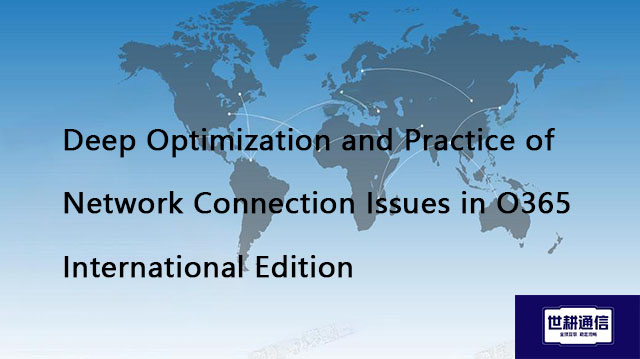Case study on network optimization of slow access to domestic ERP servers by overseas users//Global IPLC service provider of Shigeng Communication
一、With the development of global business, more and more enterprises are facing the need for overseas branches or partners to access ERP systems located locally in China. However, cross-border network access often faces problems such as high latency, severe packet loss, and slow speed, which seriously affect business efficiency. This article will analyze the reasons and optimization solutions for slow access to domestic ERP servers by overseas users through a practical case.
1. Case background
A manufacturing enterprise headquartered in Shanghai uses the UFIDA NC system as its core ERP platform, with servers deployed in the Shanghai data center. The company has branches in Southeast Asia (Singapore, Malaysia), Europe (Germany), and North America (United States), with approximately 200 overseas users. With the expansion of business, overseas users generally reflect that:
Logging into the ERP system is slow, sometimes taking 2-3 minutes to enter
The operation response is significantly delayed, and simple document saving takes 10-15 seconds
Frequent connection interruptions during peak hours
The report export function is basically unusable
2. Problem diagnosis
1. Network link testing
By testing the network connections in three regions using traceroute and ping tools, it was found that:
Average latency: 180ms in Southeast Asia, 320ms in Europe, 280ms in North America
Packet loss rate: average 5-8%, can reach up to 15% during peak hours
Routing hops: generally between 18-22 hops, with some routes bypassing the United States before returning to Asia
2. Analysis of bandwidth usage
Monitoring shows that the utilization rate of international export bandwidth during business hours (9:00-11:00 local time) is over 85%, indicating significant congestion.
3. Application layer analysis
The ERP system is not optimized for high latency environments, and frequent small packet requests exacerbate the impact of latency
Lack of compression mechanism, slow loading of page elements and static resources
Database queries are not cached, and overseas users need to interact with domestic servers every time they operate
4. Impact of security policies
The deep packet inspection (DPI) of firewalls and frequent SSL renegotiation add additional latency.
3. Optimize solutions
1. Network architecture optimization
a. Deploying Global Acceleration Services
Adopting global acceleration solutions from Alibaba Cloud or Tencent Cloud, utilizing their overseas POP points to optimize routing
By using BGP Anycast technology, users can access the optimal nodes nearby
b. Dedicated line/VPN replaces public network
Southeast Asian branch: Deploy MPLS dedicated line, latency reduced to below 80ms
European and American branches: using IPSec VPN over SD-WAN to dynamically select the optimal path
c. CDN Static Resource Distribution
Distribute static resources (JS/CSS/images) from ERP to overseas nodes through CDN
Enable HTTP/2 and Brotli compression to improve transmission efficiency
2. Application layer optimization
a. Front end optimization
Implement front-end caching to reduce duplicate requests
Adopting asynchronous loading and lazy loading techniques
Merge API requests to reduce the number of requests
b. Backend optimization
Add Redis caching layer to cache commonly used data
Optimize database queries and add appropriate indexes
Implement paging and incremental loading mechanisms
c. Protocol optimization
Enable QUIC protocol instead of TCP to improve performance in high latency environments
Adjust TCP window size and KeepAlive parameters
3. Architecture improvement
a. Regional distributed deployment
Deploy read-only replicas in Southeast Asia (Singapore) to handle query requests
Key businesses are still being written back to the central database to ensure data consistency
b. Data synchronization strategy
Implementing Near Real Time Data Synchronization with GoldenGate
Non critical report data allows for a certain delay
4. Other optimizations
Adjust firewall policies to reduce unnecessary deep packet inspection
Optimize SSL configuration, enable session reuse and OCSP Sampling
Implement QoS strategy and prioritize ensuring ERP traffic
Through this case, it can be seen that solving the problem of slow overseas access to domestic ERP requires systematic planning and multi-faceted optimization measures. Enterprises should choose the most suitable optimization combination plan based on their own business characteristics, user distribution, and IT budget.

二、Shigeng Communication Global Office Network Products:
The global office network product of Shigeng Communication is a high-quality product developed by the company for Chinese and foreign enterprise customers to access the application data transmission internet of overseas enterprises by making full use of its own network coverage and network management advantages.
Features of Global Application Network Products for Multinational Enterprises:
1. Quickly access global Internet cloud platform resources
2. Stable and low latency global cloud based video conferencing
3. Convenient and fast use of Internet resource sharing cloud platform (OA/ERP/cloud storage and other applications
Product tariff:
Global office network expenses | Monthly rent payment/yuan | Annual payment/yuan | Remarks |
Quality Package 1 | 1000 | 10800 | Free testing experience for 7 days |
Quality Package 2 | 1500 | 14400 | Free testing experience for 7 days |
Dedicated line package | 2400 | 19200 | Free testing experience for 7 days |







